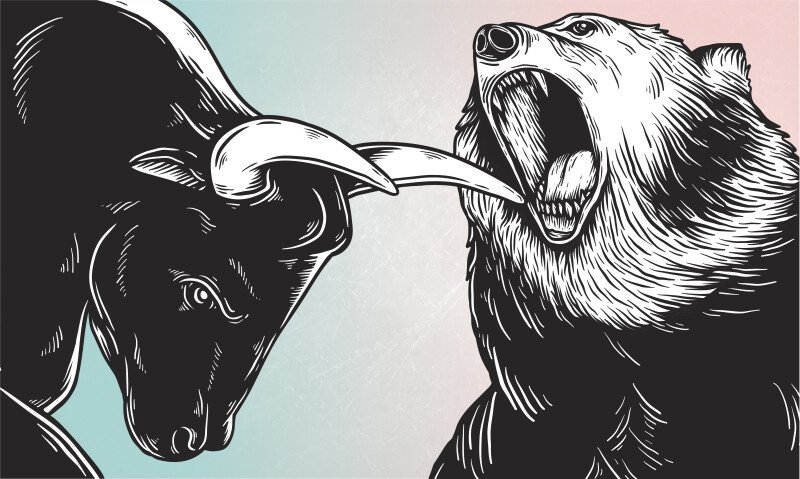Stock market investing can sometimes seem like a random game. You might find out one morning that your investments have increased by 5% over night, but six months later, you may experience an unexpected crash and lose all of your gains.
What if I told that the so-called randomness is actually a lifecycle we can predict and take into account in our trading decisions. You can’t miss the fact that our economy has booms and crashes. These are called bull markets and bear market for our investment. Although the names may sound similar, they are very different. We’ll look at the differences between bull and bear markets, how they work, and what you can expect.
What is a Bull Market?
Bull Market or Bear Market? What you need to know
Let the good times roll. That’s how I would sum up a bullish market. During a market bull, the economy looks great, stocks are up, and unemployment rates are low. What else could you want? A bull market technically is a period of time where prices increase — usually by 20% or higher.
The trend continues, and prices continue to rise. This encourages investors to buy, resulting in a positive cycle of price increases. This is the time of year when investors can make the most profit because everything is booming. It sounds amazing, doesn’t it? The good times won’t last forever. Bull markets can last anywhere from four to eleven years on average. However, they can end as quickly as few months.
Types of bull markets
Bull Market or Bear Market? What you need to know
Bull markets are often referred to when discussing stock market indices, such as the S&P 500 or Dow Jones Industrial Average. Bull markets can happen in all types of markets. Here are some of the most common types:
Stock bull markets. Stock bull markets.
Gold bull markets. When the stock market is in turmoil, physical gold, gold ETFs and gold stocks do well. After a long bull run for stocks ended in 2000, the gold market went on a bull run from 2000 to 2011
Bond bull markets. Bonds have not experienced extremes as recent as other assets. Since the 1980s, bonds have been in a bullish market, with no negative returns (although that may soon change).
Foreign exchange bull markets. Forex trading is done in pairs, so it works differently. One currency may strengthen and enter a bullish market, while another can weaken and fall into one.
Secular bull markets. Secular bull markets have nothing to do religiously. They describe a long-term market that encompasses various asset types.
A new development in cryptocurrency is bull markets. However, as we are still at the beginning of this phenomenon, further research will be needed to better understand them. It’s become apparent that cryptocurrency bull markets are a very real phenomenon. Just look at the peaks and crash of Bitcoin.
What is a Bear Market?
Bull Market or Bear Market? What you need to know
Bear markets are a reflection of this downward movement. These mechanisms are similar to bull markets, but everything is reversed: Prices decline and more investors sell which leads to prices continuing to decline. You can expect high unemployment and slow growth as a result of falling prices. It may sound like an investment disaster, but it’s not necessarily the case. Just like bull markets, they can’t last forever. This means that bear markets offer investors a great opportunity to profit. Bear markets are possible for any type of investment or asset.
Understanding Bull Markets & Bear Markets
Bull Market or Bear Market? What you need to know
The economic cycle is not a binary system. Both bull markets and bear market are part of it. The bull market is in full force during the expansion of the economy. After it reaches its peak it begins to morph into a bear-market. We’ve already discussed that bull and bear markets are not limited to just investments. They can also refer to assets or commodities. At any moment, there could be a bullish market for cryptocurrencies, but a bearish market for stocks. There can also be no bull or bear market – the market may simply be in flux.
The curious among you may be wondering why these two markets were given their names. Etymologists say the term bear market comes from the old proverb “it’s not wise to sell the skin of the bear before you’ve caught it.” Bearskin became a symbol for stocks, and was linked to the belief that investors sold their stock in anticipation that its price would fall. It’s possible that the image of a bull was chosen to symbolize those who rush to buy stock when prices are rising, similar to a bull running toward a flag. These visuals have been with us since the 18th century.
Real-Life Examples
Bull Market or Bear Market? What you need to know
It is not necessary to look back too far to find examples of bull and bear markets. Before the COVID-19 outbreak, we were experiencing the longest bull run in history. It lasted from March of 2009 to March of 2020. Over this period, the S&P500 grew by over 400%. Anyone who invested in 2009 would have been very wealthy by now. Unfortunately, depending on who you talk to, this means that a bearish market will come at some point. However nobody knows when. The previous record of the longest bull run was between October 1990 to March 2000.
The Great Depression is a good example of a decline. The Dow Jones Index dropped by around 80% between 1928 and 1932. The Dow Jones Index fell for four years in a row, which is the longest decline of any bear market. We can see similar trends in micro. The pandemic in March 2020 ended the long bull run we had been enjoying. The transition from the peak of March 23rd 2020 to its lowest point in history took just 33 days. This was the fastest peak-to-trough transition ever recorded.
It recovered almost as fast, reaching its prior high in just five months. Investors were likely to have been confident that their governments would take the necessary measures to protect them from the effects of pandemic, and therefore that the market could rebound quickly.
What Should you do if the market is in a bull or bear market?
Bull Market or Bear Market? What you need to know
It doesn’t matter how much you know about the theory if you don’t use it to improve your trading and investment decisions. You should know that a bull and bear market are not mutually exclusive. Chances are, your investments will eventually regain the value they lost. The correct reaction depends on several factors. How much risk can you tolerate? You may not be able to tolerate seeing the value of your investments drop for a period.
Consider your investment time frame. Are you looking to maximize profits in a few years or do you want to see quick returns? Swing traders can identify stocks likely to rise in value in the early stages of a bull run and then sell them at their peak. It’s not easy, but the rewards can be huge. You could also choose to be safe and buy stocks you believe have high long-term value at a low price during a bearish market in the hope of seeing huge gains down the road. If you “can” (get it?) If you can “bear” (get it?)
Feeling bullish?
Bull Market or Bear Market? What you need to know
Understanding how bull and bear markets function is a great thing to do as an investor. You can’t expect to make above-average profits if you do not understand how the stock markets work. A word of caution, though: bear and bull markets may not be easy to predict or exploit. In retrospect the market’s trends may seem obvious, but they are rarely so in the heat. You’ll be able to tell whether or not you want to take advantage of the bear or bull market swings.
This article was originally published on Wealth of Geeks. It has been republished by permission.







